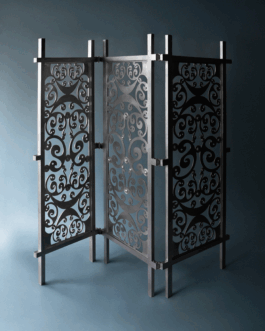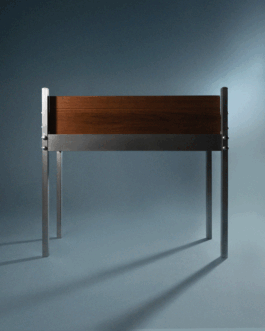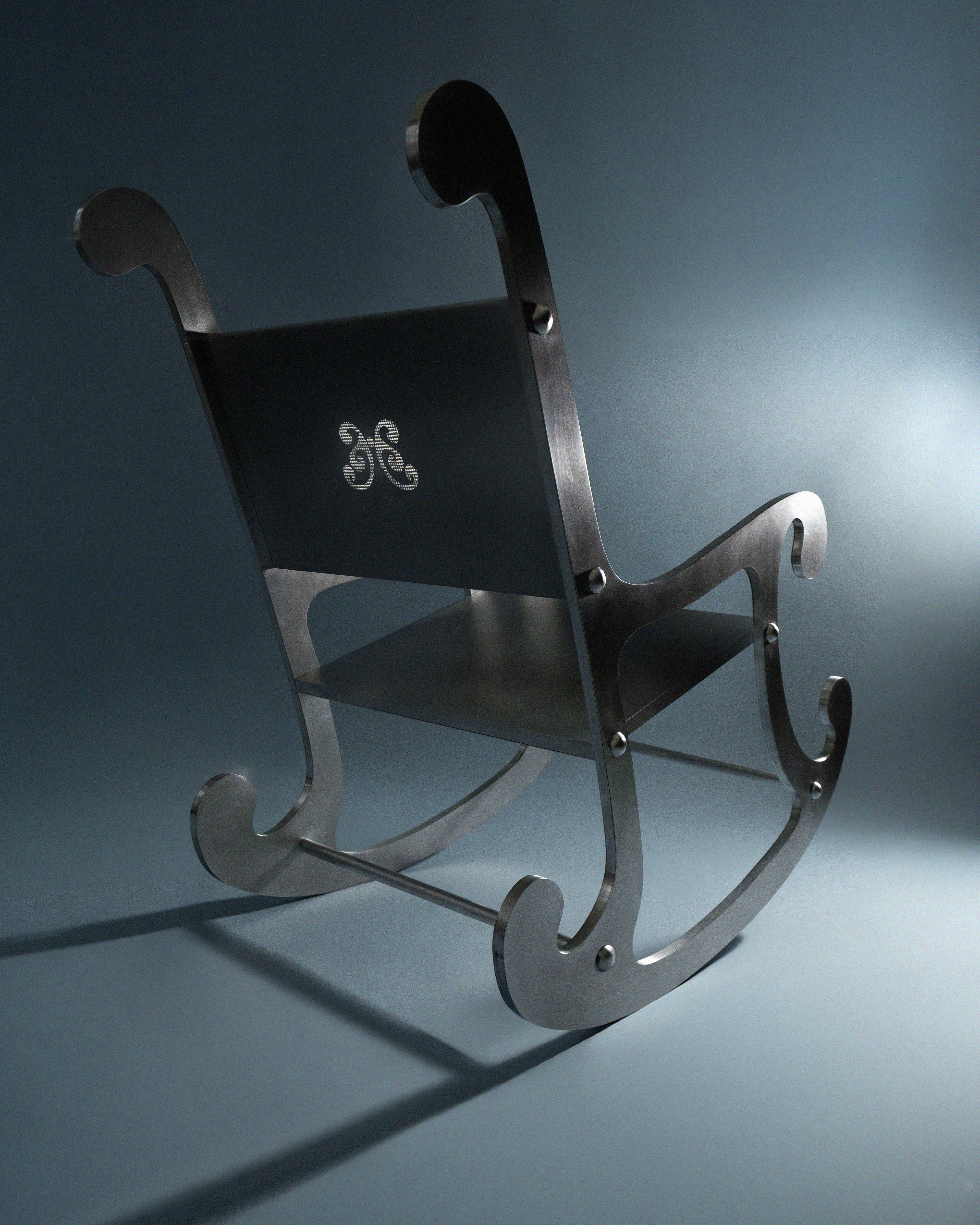



©Parabán, MDF, aluminum, 2024. Designed by Maria Laura Camejo. Courtesy of Concordia Studio.
COLLECTIBLE In-Depth
Concordia Studio presenting Maria Laura Camejo
August 2025
This series, COLLECTIBLE In-Depth, unveils the backstage of contemporary creation. Tackling various topics from personal designer processes to the position of collectible design on the global design market, COLLECTIBLE In-Depth offers different views to suit all tastes. Today we speak with Concordia Studio.
EDITORIAL
For Designers: Maria Laura Camejo
COLLECTIBLE: Can you talk about a new piece / collection that you release for COLLECTIBLE this year?
Maria Laura Camejo: This year at COLLECTIBLE I’m presenting Inventario, a limited-edition furniture collection that reimagines foundational objects from my childhood home in Venezuela. The series includes a trunk, a rocking chair, and a room divider—each originally made of wood, now reinterpreted in metal. That material shift speaks to the transformation that comes with migration: the hardness of distance against the warmth of memory. The idea began last year after returning to Venezuela for the first time in six years and finding my family’s belongings stored away in my grandfather’s house—objects once part of daily life now felt archival. Each piece embodies both preservation and change, inviting the viewer to consider how home evolves when it exists across time and geography.
C: How do you navigate the tension between innovation and tradition in your approach to designing collectible objects?
MLC: With Inventario, I began with domestic archetypes rooted in my Venezuelan upbringing, pieces once crafted in warm woods and imbued with personal history. Innovation emerged through material and form: translating them into metal, refining their lines, altering their proportions. This shift doesn’t aim to replace tradition, but to refract it—revealing how familiar objects can inhabit new identities. In collectible design, I’m interested in that space where heritage and experimentation coexist, so an object remains rooted in its cultural memory yet resonates within a contemporary context.
C: How did you get into collectible design? Why did you focus your practice on this type of design rather than industrial design?
MLC: I’ve always seen objects as a way to tell stories. Studying product design was my way of learning the language—understanding materials, proportions, and processes—but even then, I gravitated toward pieces that were more conceptual than purely functional ones. Over time, I realized that the constraints of industrial production didn’t leave enough room for the kind of storytelling I wanted to do. Collectible design gave me that freedom: to create objects that carry personal narratives and cultural memory, without having to adapt them for mass manufacturing. With Inventario, each piece is rooted in my own history, made with the intention and experimentation that have always guided my work.
C: How can collectible design be a representation or reaction to the current societal, political or economic questions?
MLC: Collectible design is one of the few design disciplines that can slow down and respond to the world, rather than simply serve it. Because these pieces are often made in small editions and outside the constraints of mass production, they can address ideas that are personal, political, or even uncomfortable. They can hold memory, respond to loss, question systems, or imagine alternative futures. In my own work, I see it as a way to process the realities of migration and displacement—abstracting objects from my past to reflect how distance reshapes them. But that’s just one example; across the field, collectible design is uniquely positioned to translate societal, political, and economic questions into tangible forms that invite reflection.
C: How do collaborations with artisans or craftspeople influence the final outcome of your collectible design pieces?
MLC: Collaborating with skilled craftspeople changes the work in ways I could never anticipate. I was fortunate to work with Theo, Alfredo, and Eliseo in Mexico, who helped translate the ideas behind Inventario into tangible pieces. Their technical knowledge and problem-solving turned concepts into forms that could only exist through collaboration. The designs evolved through our conversations and the refinements we made along the way. That exchange is one of my favorite parts of making collectible design—the moment when a personal vision meets the hands and expertise of others, and something unexpected takes shape.
EDITORIAL
For Gallerists: Concordia Studio Danielle Juliao (Founder + Director at Concordia Studio), Martin Isaza (Guest Curator and Art Dealer), and Marines Soria (Guest Producer)
COLLECTIBLE: What are the key questions you ask yourself before starting to conceptualize an exhibition?
Concordia Studio: Before starting any project, we ask ourselves: Who do we want to work with? How does their practice align with our vision? What story are they telling and how can we highlight it through exhibition design? Which space or format will allow the work to be understood in the right way? How can we use our lack of a fixed space as an advantage? And what is the most intentional, minimal way to design the exhibition so every element has a purpose? Concordia Studio is an ephemeral gallery, and this flexibility allows us to create unique, unrepeatable projects, often with emerging and mid-career artists and designers from Latin America whose work tells regional stories.
Many collaborators come from long-standing relationships, such as our represented designer at Collectible, Maria Laura Camejo, whom Danielle (Concordia’s founder) met over a decade ago at Parsons while they were roommates, sparking years of experimental collaboration. Maria Laura’s deep connection to Venezuela gives us an intimate understanding of her work, building the trust that makes collaboration flow naturally. As strategic designers ourselves, we prototype and plan each exhibition’s spatial and curatorial vision, starting broad and refining into a minimal, intentional concept where every element, from wall color to surrounding materials, serves the work, creating a design-forward yet purpose-driven environment..
C: What can collectible design bring to the daily lives of the people who collect?
CS: Collectible design enriches daily life by telling stories, deepening cultural context, and inviting a sense of play into adulthood. It encourages mixing aesthetics, honoring intricate craftsmanship, and honest materials, which then translates into interesting conversations within the most intimate setting of all - the home. We believe that eclecticism can be both inspiring and educational and practice it ourselves. Beyond decoration, these pieces become touchpoints for learning, memory, and connection, and we learned this lesson through our families from an early age.
We also believe 21st-century design holds a special importance. When we connect with a contemporary piece, it becomes a memento of the time we are living, capturing what we are experiencing personally, as well as the cultural markers shaping the spirit of the era.

©Baúl, tzalam, aluminum, 2024. Designed by Maria Laura Camejo. Courtesy of Concordia Studio.

© Baúl, tzalam, aluminum, 2024. Designed by Maria Laura Camejo. Courtesy of Concordia Studio.

©Parabán, MDF, aluminum, 2024. Designed by Maria Laura Camejo. Courtesy of Concordia Studio.
COLLECTIBLE In-Depth
Concordia Studio presenting Maria Laura Camejo
August 2025
This series, COLLECTIBLE In-Depth, unveils the backstage of contemporary creation. Tackling various topics from personal designer processes to the position of collectible design on the global design market, COLLECTIBLE In-Depth offers different views to suit all tastes. Today we speak with Concordia Studio.
EDITORIAL
For Designers: Maria Laura Camejo
COLLECTIBLE: Can you talk about a new piece / collection that you release for COLLECTIBLE this year?
Maria Laura Camejo: This year at COLLECTIBLE I’m presenting Inventario, a limited-edition furniture collection that reimagines foundational objects from my childhood home in Venezuela. The series includes a trunk, a rocking chair, and a room divider—each originally made of wood, now reinterpreted in metal. That material shift speaks to the transformation that comes with migration: the hardness of distance against the warmth of memory. The idea began last year after returning to Venezuela for the first time in six years and finding my family’s belongings stored away in my grandfather’s house—objects once part of daily life now felt archival. Each piece embodies both preservation and change, inviting the viewer to consider how home evolves when it exists across time and geography.
C: How do you navigate the tension between innovation and tradition in your approach to designing collectible objects?
MLC: With Inventario, I began with domestic archetypes rooted in my Venezuelan upbringing, pieces once crafted in warm woods and imbued with personal history. Innovation emerged through material and form: translating them into metal, refining their lines, altering their proportions. This shift doesn’t aim to replace tradition, but to refract it—revealing how familiar objects can inhabit new identities. In collectible design, I’m interested in that space where heritage and experimentation coexist, so an object remains rooted in its cultural memory yet resonates within a contemporary context.
C: How did you get into collectible design? Why did you focus your practice on this type of design rather than industrial design?
MLC: I’ve always seen objects as a way to tell stories. Studying product design was my way of learning the language—understanding materials, proportions, and processes—but even then, I gravitated toward pieces that were more conceptual than purely functional ones. Over time, I realized that the constraints of industrial production didn’t leave enough room for the kind of storytelling I wanted to do. Collectible design gave me that freedom: to create objects that carry personal narratives and cultural memory, without having to adapt them for mass manufacturing. With Inventario, each piece is rooted in my own history, made with the intention and experimentation that have always guided my work.
C: How can collectible design be a representation or reaction to the current societal, political or economic questions?
MLC: Collectible design is one of the few design disciplines that can slow down and respond to the world, rather than simply serve it. Because these pieces are often made in small editions and outside the constraints of mass production, they can address ideas that are personal, political, or even uncomfortable. They can hold memory, respond to loss, question systems, or imagine alternative futures. In my own work, I see it as a way to process the realities of migration and displacement—abstracting objects from my past to reflect how distance reshapes them. But that’s just one example; across the field, collectible design is uniquely positioned to translate societal, political, and economic questions into tangible forms that invite reflection.
C: How do collaborations with artisans or craftspeople influence the final outcome of your collectible design pieces?
MLC: Collaborating with skilled craftspeople changes the work in ways I could never anticipate. I was fortunate to work with Theo, Alfredo, and Eliseo in Mexico, who helped translate the ideas behind Inventario into tangible pieces. Their technical knowledge and problem-solving turned concepts into forms that could only exist through collaboration. The designs evolved through our conversations and the refinements we made along the way. That exchange is one of my favorite parts of making collectible design—the moment when a personal vision meets the hands and expertise of others, and something unexpected takes shape.
EDITORIAL
For Gallerists: Concordia Studio Danielle Juliao (Founder + Director at Concordia Studio), Martin Isaza (Guest Curator and Art Dealer), and Marines Soria (Guest Producer)
COLLECTIBLE: What are the key questions you ask yourself before starting to conceptualize an exhibition?
Concordia Studio: Before starting any project, we ask ourselves: Who do we want to work with? How does their practice align with our vision? What story are they telling and how can we highlight it through exhibition design? Which space or format will allow the work to be understood in the right way? How can we use our lack of a fixed space as an advantage? And what is the most intentional, minimal way to design the exhibition so every element has a purpose? Concordia Studio is an ephemeral gallery, and this flexibility allows us to create unique, unrepeatable projects, often with emerging and mid-career artists and designers from Latin America whose work tells regional stories.
Many collaborators come from long-standing relationships, such as our represented designer at Collectible, Maria Laura Camejo, whom Danielle (Concordia’s founder) met over a decade ago at Parsons while they were roommates, sparking years of experimental collaboration. Maria Laura’s deep connection to Venezuela gives us an intimate understanding of her work, building the trust that makes collaboration flow naturally. As strategic designers ourselves, we prototype and plan each exhibition’s spatial and curatorial vision, starting broad and refining into a minimal, intentional concept where every element, from wall color to surrounding materials, serves the work, creating a design-forward yet purpose-driven environment..
C: What can collectible design bring to the daily lives of the people who collect?
CS: Collectible design enriches daily life by telling stories, deepening cultural context, and inviting a sense of play into adulthood. It encourages mixing aesthetics, honoring intricate craftsmanship, and honest materials, which then translates into interesting conversations within the most intimate setting of all - the home. We believe that eclecticism can be both inspiring and educational and practice it ourselves. Beyond decoration, these pieces become touchpoints for learning, memory, and connection, and we learned this lesson through our families from an early age.
We also believe 21st-century design holds a special importance. When we connect with a contemporary piece, it becomes a memento of the time we are living, capturing what we are experiencing personally, as well as the cultural markers shaping the spirit of the era.

©Baúl, tzalam, aluminum, 2024. Designed by Maria Laura Camejo. Courtesy of Concordia Studio.

© Baúl, tzalam, aluminum, 2024. Designed by Maria Laura Camejo. Courtesy of Concordia Studio.
Contact
info@collectible.design
VIP PORTAL
EXHIBITOR PORTAL
PRIVACY POLICY
© 2025 Collectible
Contact
info@collectible.design
VIP PORTAL
EXHIBITOR PORTAL
PRIVACY POLICY
© 2025 Collectible